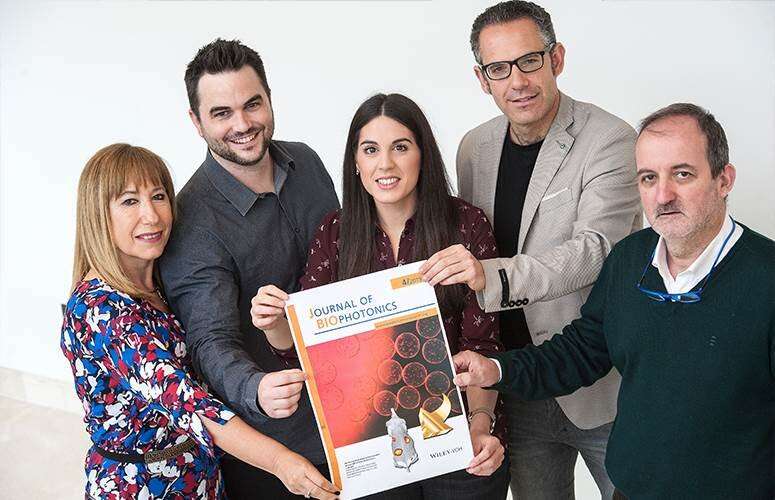From left to right, Rosa María Hernández, Edorta Santos Vizcaino, Ainhoa Gonzalez Pujana, Gorka Orive and José Luis Pedraz. Credit: Nuria González. UPV/EHU.
Researchers at the UPV/EHU-University of the Basque Country have developed a biomedical device for cell immune-isolation (microcapsules) with luminescence for in vivo tracking. The work has been published in the Journal of Biophotonics.
Researchers in the UPV/EHU's NanoBioCel group together with the University of Michigan (USA), have developed biomedical microcapsules for cell immune-isolation with an intrinsic capability enabling it to be tracked once implanted in the organism. The innovative design exploits a natural substance called genipin, which emits intense, stable fluorescence in the far-red range.
The noninvasive monitoring of biosystems based on implanted hydrogels generally requires indirect labelling of the vehicle or cargo, which increases the complexity and potential risk that its functionality may be altered. For the first time, this group of researchers has shown that hydrogel-based biosystems can be produced using biomaterials with intrinsic properties for the purpose of noninvasively monitoring them, in this case by using genipin.
"It is important to point out that until now, nobody has exploited the natural fluorescence emitted by genipin as a noninvasive monitoring system in cell therapies implanted in living beings," say the researchers. "As a first milestone, we have developed an innovative immune-isolation device that has genipin built into its design, which means it can be tracked once implanted in the organism. Through a fast, efficient, non-cytotoxic procedure, we have maximised the fluorescence of the microcapsules, achieving an excellent signal-to-noise ratio. We have also validated the use of genipin as a quantitative imaging probe by demonstrating that intense, stable fluorescence with good linearity of signal to dose of implanted microcapsules is obtained over several weeks. Through this strategy, we have managed to evaluate the actual dose injected and to monitor its position over time, which significantly improves the biosecurity and efficacy of the therapy."
The idea could also have a potentially successful application in the industry of nano-, micro- and macro-technologies based on hydrogels. These are destined to be essential components both for biomedical research and for advances in clinical medicine through applications, such as tissue engineering, regenerative medicine. "As these fluorescence imaging systems are gradually implemented in clinical practice, we believe that our proposal could be successfully applied in furthering a whole host of biotechnologies based on hydrogels, including the systems for delivering drugs and cells, vaccines or biosensors," they concluded.
More information: Edorta Santos‐Vizcaino et al. Monitoring implantable immunoisolation devices with intrinsic fluorescence of genipin, Journal of Biophotonics (2018). DOI: 10.1002/jbio.201800170
Provided by University of the Basque Country






















